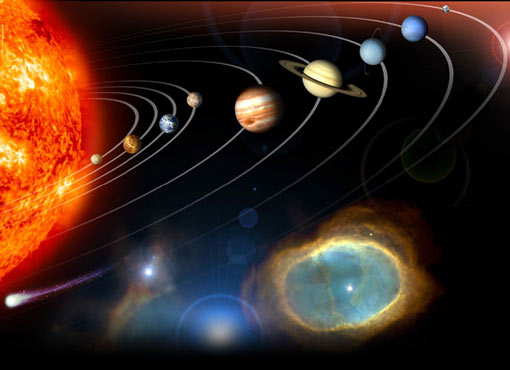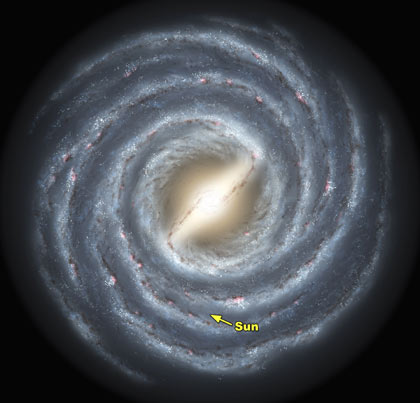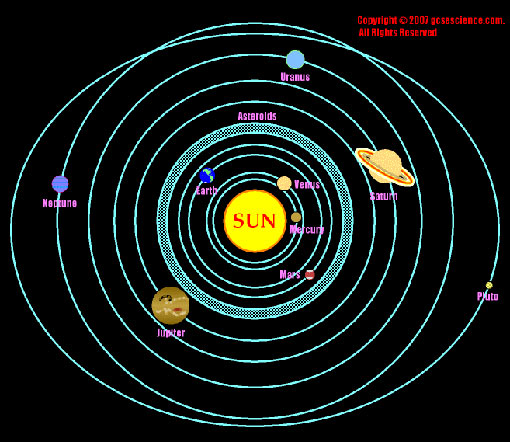You are hereSolar system moving 100000 mph faster than thought; 15% speed increase translates to doubling of mass of Milky Way /
Solar system moving 100000 mph faster than thought; 15% speed increase translates to doubling of mass of Milky Way

(quote)
It turns out that our solar system is moving nearly 100,000 m.p.h. faster than previously thought — revolving around the center of the Milky Way at 568,000 m.p.h., announced Mark Reid of the Harvard-Smithsonian Center for Astrophysics on Monday at the American Astronomical Society's conference in Long Beach, Calif. Since velocity is related to mass, the 15% increase in solar-system speed translates into a near doubling of mass of the Milky Way, according to Reid's group — and all of that newfound bulk is composed of dark matter.

Original estimates of the solar system's speed were based on what Reid calls "one- dimensional velocity" obtained solely from Doppler shifts. "Now," he says, "we have three-dimensional velocity and more exact measurements" — a huge advancement in the field. The findings debunk the notion that the Milky Way is a little-sister galaxy to her neighbor Andromeda. "They're more like fraternal twins," Reid says. And the fact that they are of equal size increases the likelihood that the two will someday collide.
But humans needn't flee the galaxy anytime soon. First, there's so much room between stars that Earth likely wouldn't feel any effects of a galactic collision, though our constellations would certainly change. And second, a crash is still about 3 billion to 5 billion years away, by which time our sun will have transformed into a red giant and turned the Earth into a smidgen of charred dust.

A flurry of recent findings has provided a clearer understanding of the Milky Way than ever before. Just a few weeks before Reid's announcement, Martin Pohl, an associate professor of physics and astronomy at Iowa State University, revealed the most detailed map to date of the galaxy's spiral arms. Pohl's map establishes that there are two symmetric arms in the inner part of the galaxy that branch off into four — answering a question that astrophysicists have grappled with for 50 years. (According to Pohl, our solar system is located near one of the branching-off points, about 28,000 light-years — or 168 quadrillion miles — from the galactic center.)
*Update July 19, 2012*
"Astronomers announced that they have viewed for the first time a spiral galaxy from the early universe. The scientists believe that this particular spiral galaxy formed billions of years before other spiral galaxies. The astronomers discovered the ancient spiral galaxy using the Hubble Space Telescope to take pictures of roughly 300 very distant galaxies in order to study the galaxy properties.
The old spiral galaxy is being observed, as it would've been roughly 3 billion years after the formation of the universe. Astronomers also note that the light from this part of the universe has been traveling to Earth for 10.7 billion years. Our own Milky Way galaxy is a spiral galaxy.
The astronomers say that the fact that this galaxy exists is astounding. The scientists note that current wisdom believed that such spiral galaxies didn't exist at such an early time in the history of the universe. This particular spiral galaxy is termed a grand design galaxy because it has prominent and well formed spiral arms. Scientists have dubbed the galaxy BX442."
First spiral galaxy in early Universe stuns astronomers
Astronomers have spotted the earliest known spiral galaxy, dating to just three billion years after the Big Bang. Theories of galaxy formation held that the Universe was still too chaotic a place to allow such a perfectly formed or "grand-design" spiral to form.
It should take far longer for gravity to bring matter into thin, neat discs. But a team reporting in Nature says the galaxy BX442 got the gravitational "kick" it needed to form a spiral from a smaller "dwarf galaxy" orbiting it.
(unquote)
Photos courtesy of scienceclass.ning.com, lns.mit.edu, and gcsescience.com
Original Source: Time
Reply








